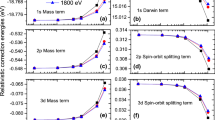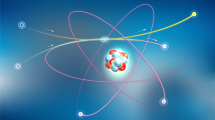Abstract
Here we present a self-consistent relativistic screened-hydrogenic model (SHM) based on the average-atom model (AAM) for effective calculation of the energy levels of many-electron atoms immersed in plasmas. In addition, we use diverse atomic codes using the configuration interaction method, to calculate the influence of electron density and temperature on the spectra of the diverse ionic states present in a plasma focus device, as well as in other dense plasma systems. The parameters of the AAM are introduced in a coupled system of Saha equations to find the densities and abundances of the different ions to obtain the effective charges and eigenenergies of hydrogenic bound states within the framework of a self-consistent Ion Sphere Model. The results of our calculations are compared with experimental data obtained by different authors and some discrepancies between theoretical and experimental spectra are explained.
Graphic Abstract


Similar content being viewed by others
Data Availability Statement
This manuscript has associated data in a data repository. [Authors’ comment: The datasets generated during the current study are available under request.]
References
R.P. Feynman, N. Metropolis, E. Teller, Equations of state of elements based on the generalized fermi-thomas theory. Phys. Rev. 75, 1561–1573 (1949). https://doi.org/10.1103/PhysRev.75.1561
R.D. Cowan, J. Ashkin, Extension of the Thomas-Fermi-Dirac statistical theory of the atom to finite temperatures. Phys. Rev. 105, 144–157 (1957). https://doi.org/10.1103/PhysRev.105.144
B.F. Rozsnyai, Relativistic hartree-fock-slater calculations for arbitrary temperature and matter density. Phys. Rev. A 5, 1137–1149 (1972). https://doi.org/10.1103/PhysRevA.5.1137
F. Lanzini, H.O. Di Rocco, An implementation of the average atom model using the thermodynamic consistency condition: Application to Ar. Acta Phys. Pol. A 134, 1126–1133 (2018)
H.O. Di Rocco, F. Lanzini, The influence of the continuum lowering on transition probabilites: competition between cancellation and opacity effects. High Energy Density Phys. 33, 100702 (2019). https://doi.org/10.1016/j.hedp.2019.100702
A.F. Nikiforov, V.G. Novikov, V.B. Uvarov, Quantum-Statistical Models of Hot Dense Matter. Methods for Computation Opacity and Equation of State (Birkhä, Bael, Switzerland, 2005)
I.I. Sobelman, L.A. Vainshtein, E.A. Yukov, Excitation of Atoms and Broadening of Spectral Lines, 2nd edn. (Springer, Berlin, 1995)
D. Salzmann, H. Szichman, Density dependence of the atomic transition probabilities in hot, dense plasmas. Phys. Rev. A 35, 807–814 (1987). https://doi.org/10.1103/PhysRevA.35.807
D. Salzmann, Atomic Physics in Hot Plasmas (Oxford University Press, New York, USA, 1998)
J. Abdallah, R.E.H. Clark, A.Y. Faenov, L. Karpinski, S.A. Pikuz, V.M. Romanova, A. Szydlowski, Electron beam effects on the spectroscopy of multiply charged ions in plasma focus experiments. J. Quant. Spectrosc. Radiat. Transfer 62, 85–96 (1999). https://doi.org/10.1016/S0022-4073(98)00073-9
M. Fatih Yilmaz, A. Eleyan, L.E. Aranchuk, J. Larour, Spectroscopic analysis of X-pinch plasma produced on the compact LC-generator of Ecole Polytechnique using artificial neural networks. High Energy Density Phys. 12, 1–4 (2014). https://doi.org/10.1016/j.hedp.2014.04.001
R.D. Cowan, The Theory of Atomic Structure and Spectra (University of California Press, Berkeley, 2001)
W. Eissner, M. Jones, H. Nussbaumer, Techniques for the calculation of atomic structures and radiative data including relativistic corrections. Comput. Phys. Commun. 8, 270–306 (1974). https://doi.org/10.1016/0010-4655(74)90019-8
N.R. Badnell, Dielectronic recombination of Fe22+ and Fe21+. J. Phys. B: At. Mol. Phys. 19, 3827–3835 (1986). https://doi.org/10.1088/0022-3700/19/22/023
V.V. Karasiev, L. Calderín, S.B. Trickey, Phys. Rev. E 93, 063207 (2016). https://doi.org/10.1103/PhysRevE.93.063207
I.P. Grant, Relativistic Quantum Theory of Atoms and Molecules (Springer, Berlin, 2007)
A.F. Nikiforov, V.G. Novikov, V.B. Uvarov, A modified Hartree-Fock-Slater model for matter with given temperature and density, problems of atomic science and technology. Methods Codes Numer. Sol. Probl. Math. Phys. 4(6), 16–26 (1979)
S.M. De Carvalho, M. Rotondo, J.A. Rueda, R. Ruffini, Relativistic Feynman-Metropolis-teller treatment at finite temperatures. Phys. Rev. C 89(1), 015801 (2014). https://doi.org/10.1103/physrevc.89.015801
G. Faussurier, Relativistic finite-temperature Thomas-Fermi model. Phys. Plasmas 24, 112901 (2017). https://doi.org/10.1063/1.5003727
A. Sherar, G. Bertuccelli, H.O. Di Rocco, Experimental and numerical study of a pulsed cold discharge. Phys. Scripta 47, 579–584 (1993). https://doi.org/10.1088/0031-8949/47/4/019
A. Kramida, Yu. Ralchenko, J. Reader and NIST ASD Team (2018). NIST Atomic Spectra Database (version 5.1), [Online]. Available: http://physics.nist.gov/asd. National Institute of Standards and Technology, Gaithersburg, MD, USA
G.C. Rodrigues, P. Indelicato, J.P. Santos, P. Patté, F. Parente, Systematic calculation of total atomic energies of ground state configurations. Atom. Data Nucl. Data Tables 86, 117–233 (2004). https://doi.org/10.1016/j.adt.2003.11.005
A. Poquérusse, Can. J. Phys. 85, 295–305 (2007)
Q. Porcherot, J.-C. Pain, F. Gilleron, T. Blenski, High Energy Density Phys. 7, 234 (2011)
J.-C. Pain, F. Gilleron, High Energy Density Phys. 15, 30 (2015)
N.V. Filippov, T.I. Filippova, A.N. Filippov, M.A. Karakin, E.Y. Khautiev, V.I. Krauz, J. Vierne, Experimental simulation of the collisionless shock wave by plasma focus. Czech. J. Phys. 50, 127–135 (2000). https://doi.org/10.1007/BF03165868
Y. Ralchenko (ed.), Modern Methods in Collisional-Radiative Modeling of Plasmas (Springer, Berlin, 2016)
M. Mizushima, Quantum Mechanics of Atomic Structure and Atomic Spectra (W. A. Benjamin, New York, 1970)
J. Bauche, C. Bauche-Arnoult, E. Luc-Koenig, M. Klapisch, Non-relative energies from relativistic radial integrals in atoms and ions. J. Phys. B At. Mol. Phys. 15, 2325–2338 (1982). https://doi.org/10.1088/0022-3700/15/15/009
J. Bauche, C. Bauche-Arnoult, O. Peyrusse, Atomic Properties in Hot Plasmas: From Levels to Superconfigurations (Springer International Publishing, Switzerland, 2015)
M.A. Mendoza, J.G. Rubiano, J.M. Gil, M. Rodríguez, R. Florido, P. Martel, E. Mínguez, A new set of relativistic screening constants for the screened hydrogenic model. High Energy Density Phys. 7, 169–179 (2011)
G.J. Bastiaans, R.A. Mangold, The calculation of electron density and temperature in Ar spectroscopic plasmas from continuum and line spectra. Spectrochim. Acta B At. Spectrosc. 40, 885–892 (1985). https://doi.org/10.1016/0584-8547(85)80059-8
P. Neumayer, B. Aurand, R. A. Costa Fraga, B. Ecker, R. E. Grisenti, A. Gumberidze, D. C. Hochhaus, A. Kalinin, M. C. Kaluza, T. Kühl, J. Polz, R. Reuschl, T. Stöhlker, D. Winters, N. Winters, Z. Yin, Evidence for ultra-fast heating in intense-laser irradiated reduced-mass targets. Phys. Plasmas, 19, 122708 (2012). https://doi.org/10.1063/1.4772773
A. Sengebusch, H. Reinholz, G. Röpke. arXiv:1709.08493v1 [physics.plasm-ph], (2017)
H.K. Chung, M.H. Chen, W.L. Morgan, Y. Ralchenko, R.W. Lee, FLYCHK: generalized population kinetics and spectral model for rapid spectroscopic analysis for all elements. High Energy Density Phys. 1, 3–12 (2005). https://doi.org/10.1016/j.hedp.2005.07.001
M. M. Bluteau, Thesis submitted to the Department of Physics of the University of Strathclyde for the Degree of Doctor of Philosophy (2019)
Author information
Authors and Affiliations
Contributions
Di Rocco conceived of the presented idea. Lanzini developed the theory and performed the average-atom model code. Aguiar verified the analytical methods and performed the numerical simulations with different codes. All authors provided critical feedback and helped shape the research, analysis and manuscript.
Corresponding author
Rights and permissions
About this article
Cite this article
Aguiar, J.C., Rocco, H.O.D. & Lanzini, F. Self-consistent screened hydrogenic model based on the average-atom model: comparisons with atomic codes and plasma experiments. Eur. Phys. J. D 75, 272 (2021). https://doi.org/10.1140/epjd/s10053-021-00277-3
Received:
Accepted:
Published:
DOI: https://doi.org/10.1140/epjd/s10053-021-00277-3




